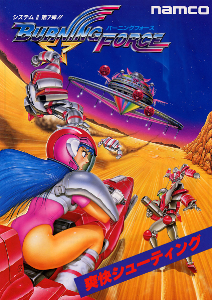Burning Force
| Burning Force | |
|---|---|

Arcade flyer
|
|
| Developer(s) | Namco |
| Publisher(s) | Namco |
| Composer(s) | Yoshinori Kawamoto |
| Platform(s) | Arcade, Sega Genesis, Virtual Console |
| Release date(s) |
Arcade
|
| Genre(s) | 3D shooter |
| Mode(s) | Up to 2 players (alternating turns) |
| Cabinet | Upright, cabaret, and cocktail |
| Arcade system | Namco System 2 |
| CPU | 2x Motorola 68000 @ 12.288 MHz Motorola M6809 @ 3.072 MHz Hitachi HD63705 @ 2.048 MHz |
| Sound |
Yamaha YM2151 C140 |
| Display | Horizontal orientation, raster, 288 x 224 resolution |
Burning Force (バーニングフォース Bāningu Fōsu?) is a 3D shooter arcade game which was released by Namco in 1989 only in Japan. It runs on Namco System 2 hardware and was later ported to the Sega Mega Drive in 1990, and was also later released on the Wii Virtual Console in 2009.
In Burning Force, the player controls a 21-year-old space cadet named Hiromi Tengenji (天元時ひろみ Tengenji Hiromi?), who as part of her final training, must battle high-tech enemies through six worlds of four areas on a futuristic airbike named "Sign Duck". The gameplay is similar to that of Sega's Space Harrier, but the worlds are divided into four areas and there is no vertical mobility making the game different in its own right; in the first two sections the player controls Hiromi on the airbike, which can move to the left and right, as well as braking and accelerating - and the airbike can also fire bullets and missiles at the enemies. The third area of every world is a boss area and the airbike will be transformed into a flying ship which can move in all directions; the fourth area of each world, however, is a bonus stage and the player has to collect as many spheres (which have numbers on them) as possible for bonus points.
The Sega Genesis / Mega Drive received mixed and mostly mediocre reviews in the West upon the release, including 4/10 from ASM, 5/10 from Génération 4, 71% from Joystick, 51% from Power Play, and 77% from RAZE, which opined "Space Harrier is too old a formula to be successful nowadays." The New Straits Times, in October 1990, dismissed the game as "yet another ... in the line of Space Harrier clones." Retrospectively, Hardcore Gaming 101's Kurt Kalata opined it "is among the better of [Space Harrier] clones, partly because it's based on more powerful arcade hardware (the Namco System-II, which ran Phelios and Valkyrie no Densetsu, amongst others), and partly because it puts its own unique spin on the formula."
...
Wikipedia
